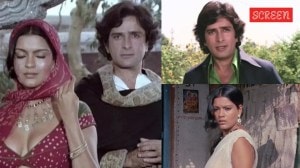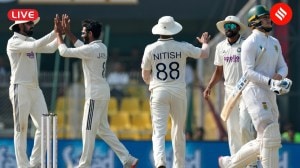Market and mayhem in Meerut
Wealth is spreading to small-town India. When will the sarkar wake up?

The footage on TV and pictures in papers brought me head on with a past I had left 16 years behind. The same city. The same fire. The same bodies. The same mortuary. The flames claimed anything between 50 and 100 lives. Sixteen years ago, the extent of the inferno was larger, though the bodies were fewer. I had walked the brick-littered streets then; I walked this time on TV. If the Meerut riots on the 1991 election eve were a harsh slap that woke me up from my school-college, carefree-living slumber and introduced the real world, the Victoria Park fire is bringing to life memories of an India that lies beyond the metro malls. If election violence put me off political reporting, yesterday’s fire is a reminder that I can run but I can’t hide.
The Meerut of 1991 was so different. With nothing better to do, the elections were a business opportunity, a revenue model, a short-term contractual career for thousands. Whipping up mass hysteria in a small town —with the cantonment was the sole semblance to what is known as the “good life” — was easy. An economy of scarcity ensured that the good life, in the form of big brands — Levi’s or Wrangler jeans, Adidas or Reebok sneakers, Sony or Sanyo stereos and so on — evaded small towns. The returns were not big enough to sustain a company outlet or a distribution network. Besides, you still had Murphy radio, Weston TV, and the good old Bata. In effect, the brands were saying: “Dear citizens of Meerut, if you want us, you’ll have to drive 70 km to Delhi or fly to Singapore.”
Today, the situation has changed. Prosperity in “small towns” makes the expression seem out of synch. In the last three years, as the Sensex quadrupled to 11,600 and rising, investments being implemented in Meerut jumped eight-fold. Of this, the biggest chunk is NHAI’s Meerut-Muzaffarnagar Highway project. In addition, projects worth more than Rs 700 crore have been announced by distilleries, builders, the Railways and power utilities. Property prices are rising, quite like the rest of India, and will perhaps outperform developed cities like Delhi.
The same brands that were too big for small towns were present there in full attire, jostling for space so that consumers of Meerut — the Bunties and the Bablies, so to speak — lent them their custom. From music systems to microwave ovens and every other consumer electronic goods in between, the brands were all there, calling out the citizens of Meerut to participate in an ancient form of community entertainment, except that the entertainment this time was shopping. In effect, the creation of a space conducive to getting people to buy. With one exception: instead of the corner kirana store extension selling bangles, toys and clothes stood global, billion-dollar brands offering gadgets on the cutting edge of technology, clothes that give the local population a global identity.
In a manner of speaking, the Brand India fair was a testimony of how when markets are freed, enterprise brings about an all-round consumer prosperity. Through higher wages that work on increased investment. Through lower prices that seek scale. Through venues that ensure purchases so that the cycle of money, from investor through worker to consumer gets completed. And it’s not just consumer goods that the world is offering Meerut. It’s equally financial products like mutual funds, stocks, banks that seek to bring the surpluses and savings of Meerut into the country’s financial mainstream, simultaneously giving an investment push and a fair to high economic return.
This fair is also a coming to terms of Meerut citizens with a reality that many have not faced. That the intellectual capital of Meerut and all other “small towns” like Bikaner, Sri Ganganagar, Siliguri, Tuticorin, Gulbarga and so on, no longer have to seek the refuge of the nearest city to get earning, investing or spending opportunities. So attractive is this opportunity that NSDL held investor depository meets in these towns over the past two months. The recent Rs 5,750 crore that Reliance Mutual Fund collected came not merely from the financial capital Mumbai or the power capital Delhi, but from 930,000 citizens of 400 towns and cities. There is a realisation, walking one small step at a time, that what the citizens of these “small towns” seek, like the young shepherd in The Alchemist, lies in their own backyards.
But while the markets, the brands, the money have reached these towns the path is still rocky. While investors, workers, consumers are here generating abundance, the foundations are still shaky. If there is one keyword that can define this weak link it is infrastructure — physical, regulatory, safety. We are told that the fair didn’t have the required permissions in the first place, but we wonder how a fair so large, so high-profile, so well-publicised an event can take place without municipal permissions. We are told that the safety infrastructure in terms of systems and exit routes was not in place. How did the fire department allow this? Investigations will follow, scapegoats will be identified, the living will count their blessings and bury their dead, and the inferno will move on to another Victoria Park.
I wonder why our otherwise very smart and suave policymakers are so good at ignoring last miles. The municipal infrastructure that is indeed the platform for all markets — open fairs, state-of-the-art malls or even broader enablers like airports — is in a shambles. This is a low-investment, high-return opportunity, which hundreds of companies will be interested in servicing. The famous public private partnership expression need not mushroom into an oxymoron. Urban renewal need not remain a paper dream that will be forgotten in the next elections. Infrastructure is indeed the hub around which all other opportunities, all other products and services, all other fairs revolve. It is the pandal where all economic marriages take place. To harness the prosperity that’s threatening to overflow into the entrails of India, this must be built in full earnest.
Write to gautam.cexpressindia.com




- 01
- 02
- 03
- 04
- 05



























